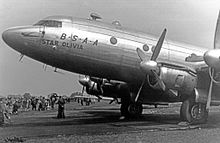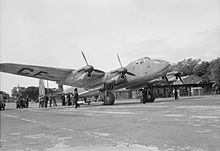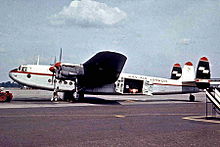British South American Airways
| British South American Airways | |
|---|---|

|
|
| IATA code : | (without) |
| ICAO code : | (without) |
| Call sign : | |
| Founding: | 1945 |
| Operation stopped: | 1950 |
| Seat: | Heathrow |
| Home airport : | London Airport |
| Fleet size: | 29 |
| Aims: | South America and the Caribbean |
| British South American Airways ceased operations in 1950. The information in italics refer to the last status before the end of operation. | |
British South American Airways ( BSAA ) was a British scheduled airline based in Heathrow near London, which operated mainly routes to Latin America from 1946 to 1949 and, on January 1, 1950, was completely incorporated into the state-owned British Overseas Airways Corporation (BOAC) as its South America division was integrated.
history
The company was originally founded by several shipping companies as British Latin American Airways in February 1944 , but the name was changed to British South American Airways in October 1945 . Flight operations began on January 1, 1946 with the first route test flight to Buenos Aires.
The company initially used Hawker Aircraft's Langley airport in Berkshire as a base, but shortly afterwards it moved to London Airport, just six kilometers south-east (renamed "London-Heathrow" in 1966). A BSAA Avro Lancastrian was the first aircraft to land at this airport, which opened in March 1946.
BSAA took its first line connection on March 15, 1946 on the route to Buenos Aires via Lisbon , Bathurst , Natal , Rio de Janeiro and Montevideo and flew this route fortnightly. Six months later, liner services to the Caribbean were set up , serving Bermuda , Jamaica and Caracas . All flights were carried out with modified bombers of the type Avro Lancastrian , which had no pressurized cabin and only offered very narrow space for 13 passengers. Because most of the transatlantic flights were carried out with the aid of astronavigation , all machines were given individual baptismal names that began with the word "Star" . With the takeover of the more spacious Avro York , 21 passengers could be transported much more comfortably. At the same time, the African stopover point was relocated from Bathurst to Dakar . In January 1947 a new route followed to Santiago de Chile via the Caribbean, Barranquilla (including overnight stay) and Lima .
The newly elected Labor government nationalized BSAA with effect from August 1, 1946.
In May 1947, BSAA began attempts at air refueling to enable non-stop flights from London to Bermuda without stopping over in the Azores . The line machine was refueled in flight by another Avro Lancaster stationed in the Azores and was able to cover the distance of 6400 km in around 20 hours. Despite a number of successful non-stop flights, the project was not pursued any further.

In 1947 bought the BSAA in the Caribbean with Vickers Viking active British West Indian Airways on (BWIA). In January 1949, Bahamas Airways was also taken over, which operated routes to Miami and Palm Beach in Florida . Flying boats of the types Grumman Goose , Consolidated Catalina , Consolidated Commodore and Republic Seabee were used on these routes .
Also in 1947 the very first, six jet aircraft of type De Havilland Comet 1 ordered, which however did not come to delivery. As an interim solution, for patriotic reasons, none of the modern American aircraft types were chosen, but the British Avro Tudor , which had been rejected as "completely unsuitable" by the state-owned British Overseas Airways Corporation (BOAC), but at least had a pressurized cabin .
An unexpected source of income opened up through the participation of BSAA in the Berlin Airlift . Five cheaply acquired Avro Tudor Vs were used for nine months to transport freight from Wunstorf .
The cockpit crews consisted mostly of previous bomber pilots. Safety factors that are crucial for civil aviation, such as the use of checklists , compliance with maximum duty times or type experience, often did not play a major role in the flight operations of the BSAA. Therefore, there were flight accidents on the demanding routes, which were characterized by long overwater stretches, a lack of ground navigation aids, poor radio links, flying over high mountain ranges and weather problems. In the four years of its existence, BSAA recorded ten total losses, including 6 fatal accidents (see below: Incidents).
After an Avro Tudor with 31 people on board disappeared without a trace on the way to Bermuda in the western Atlantic in January 1948, another Tudor disappeared between Bermuda and Kingston (Jamaica) just as mysteriously, this time with 20 people. Thereupon a flight ban was imposed on the Tudor IV as a passenger aircraft. None of this increased confidence in either the aircraft type or in BSAA and ultimately triggered the takeover of the company by BOAC, which took effect on July 30, 1949. On January 1, 1950, BSAA was then fully integrated into BOAC as its South America department and also disappeared as a brand.
fleet

When BOAC took over in September 1949, the fleet was out
As a liaison and crew transport aircraft, the following was previously used:
Incidents


In ten accidents involving the BSAA with total losses in two and a half years, a total of 95 people were killed.
- On September 7, 1946, an Avro York ( aircraft registration G-AHEW ) crashed on the flight to Natal (Brazil) shortly after taking off from Bathurst Airport , Gambia , three km south of the airport and exploded. All 24 people on board were killed (see also an Avro 685 York accident in the Gambia in 1946 ).
- On April 13, 1947, in a crash landing of an Avro York (G-TDCA) on the Dakar-Yoff airport killed six passengers in poor visibility, survived the other nine occupants.
- On August 2, the crew of the Avro 691 Lancastrian G-AGWH on the flight from Buenos Aires to Santiago de Chile reported their approach to Santiago de Chile, but the aircraft never arrived there. Apparently the crew had calculated their own position incorrectly and had flown in a snow storm at an altitude of about 4600 m against the mountain top of Tupungato , Argentina . All six passengers and five crew members were killed. The plane remained missing until some wreckage was found in the Andes in 2000 ( see also the crash of the Star Dust ) .
- On September 5, 1947, an Avro Lancastrian (G-AGWK) hit a radio mast during the approach to landing at Bermuda International Airport 1) and was irreparably damaged. All 20 people on board survived.
- On November 13, 1947 an Avro Lancastrian (G-AGWG) returned on the flight from Bermuda International Airport 1) to Santa Maria (Azores) due to an engine failure . During the emergency landing, the machine touched down in front of the runway and was destroyed. All 16 inmates survived.
- On January 30, 1948, an Avro Tudor 4 (G-AHNP) with 31 people on board disappeared without a trace over the western Atlantic between Santa Maria (Azores) and Bermuda (see also Disappearance of the Star Tiger ) .
- On January 5, 1949, a non-extinguishable engine fire broke out on an Avro York (G-AHEX) while climbing. During the necessary emergency landing near Caravelas Bay, Brazil , three passengers were killed, the other twelve occupants survived.
- On January 17, 1949, an Avro Tudor 4B (G-AGRE) with 20 people on board disappeared without a trace over the western Atlantic between Bermuda and Kingston (Jamaica) (see also Disappearance of the Star Ariel ) .
1) All kinds of aviation and shipping accidents in the so-called “ Bermuda Triangle ” immediately made headlines on the front pages at that time.
See also
literature
- Maurice J Wickstead: Airlines of the British Isles since 1919 . Staplefield, W Sussex, UK: Air-Britain (Historians) Ltd., 2014, ISBN 978-0-85130-456-4 .
Web links
- History of British South American Airways , accessed May 30, 2015
Individual evidence
- ↑ Airlines of the British Isles, p. 149
- ^ British South American Airways timetable December 1, 1948 , timetableimages.com, accessed March 8, 2020 (English).
- ↑ a b c Airlines of the British Isles, p. 150
- ^ Flight International, January 20, 1949
- ↑ a b c Airlines of the British Isles, p. 151
- ^ Aviation Safety Network, Statistics BSAA
- ^ Aviation Safety Network, Statistics BSAA
- ^ Accident report Avro York G-AHEW , Aviation Safety Network (English), accessed on January 21, 2016.
- ^ Accident report Avro York G-AHEZ , Aviation Safety Network (English), accessed on January 21, 2016.
- ↑ accident report Lancastrian G-AGWH , Aviation Safety Network (English), accessed on 23 November 2017th
- ↑ accident report Lancastrian G-AGWK , Aviation Safety Network (English), accessed on 21 January 2016th
- ↑ accident report Lancastrian G-AGWG , Aviation Safety Network (English), accessed on 21 January 2016th
- ^ Accident report Avro Tudor G-AHNP , Aviation Safety Network (English), accessed on January 21, 2016.
- ^ Accident report Avro York G-AHEX , Aviation Safety Network (English), accessed on January 21, 2016.
- ^ Accident report Avro Tudor G-AGRE , Aviation Safety Network (English), accessed on January 21, 2016.
